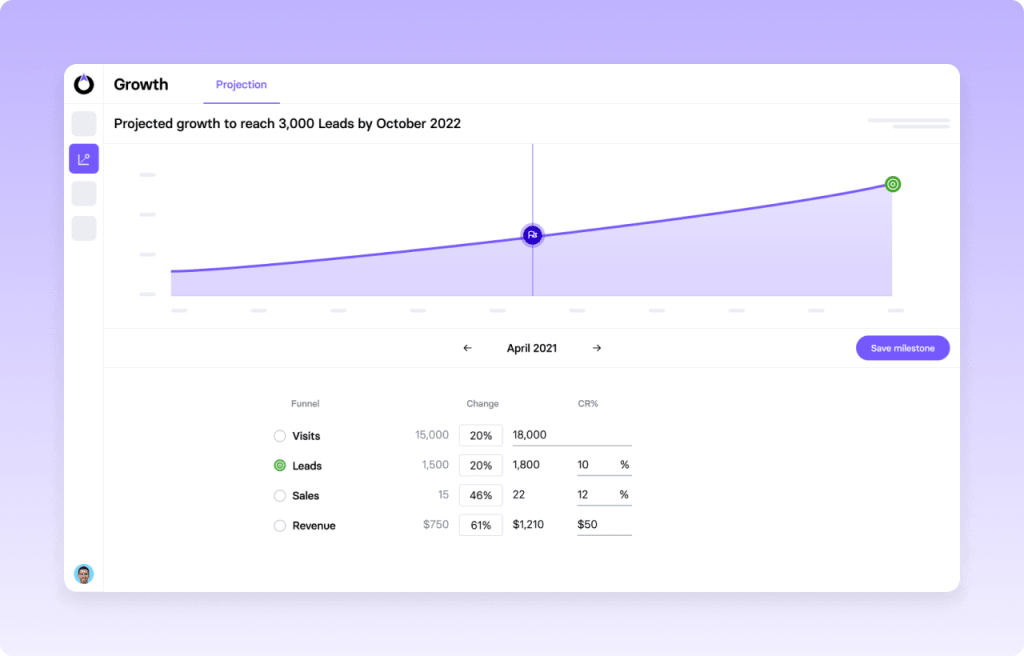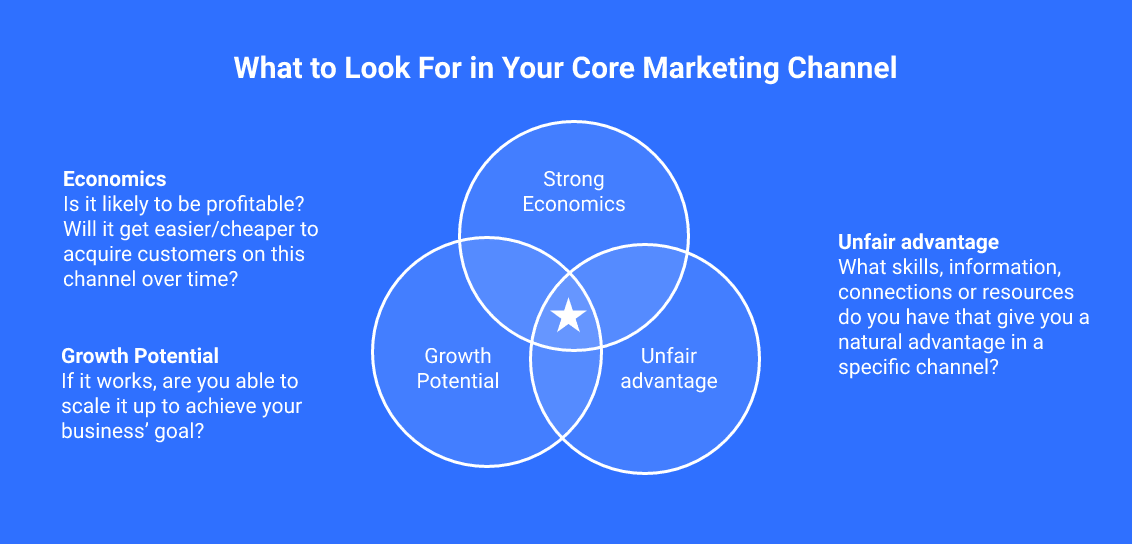Marketing plans are long overdue a re-think.
If you read most marketing planning guides, you’ll find them recommending a quarterly or annual marketing plan that’s inflexible, opinion-based, and full of frameworks dating from the 60’s.
Marketing plans should be adaptive.
They should be updated frequently when the facts change, and refined with every campaign result or insight.
They should be a source of accountability – enabling you to compare the actual results of your campaigns against what you planned to achieve.
Most marketing plans do not.
The growth marketing plan
Growth marketing has quickly established itself as a more structured, accountable, and agile marketing framework.
It replaces the old, slow and opinion-led approach to marketing planning with a fast, evidence-led approach that aims to produce prioritised experiments that can be tested and iterated on quickly, as opposed to grand campaigns.

In this guide, we’ll explore what a growth marketing plan looks like, and how to create and implement one (with examples).
What is a growth marketing plan?
A growth marketing plan is essentially a collection on prioritised experiments that aim to deliver your marketing objectives with confidence.
It’s never complete and improves with each cycle and insight. It’s a source of truth that looks forward (what do we next?) as well as backwards (what worked/didn’t work in the past?)
A growth marketing plan is made up of five parts.
- A Goal
- A Projection
- Experiments
- A roadmap/timeline
- Insights
It’s essential that all five parts are centralised in one place. If they’re fragmented across spreadsheets, Trello boards and dashboards, you’ll pay the price in speed and ability to quickly make effective decisions.
For that reason, we’re using TrueNorth (a growth marketing platform built by our team), but there are many general-purpose tools you could use.
1. The Goal
If you’re not crystal clear on what your business goal is – stop.
Trying to do marketing without a clear goal is like starting a race without knowing where the finish line is.
As a marketing team, you need to know the one metric, that if increased, will achieve the business’ desired outcomes.
In most cases, this will likely be some variant of revenue (e.g. MRR, profit, sales) or leads.
This starts by understanding where the business wants to go. If unclear, ask yourself (or stakeholders):
- How much profit does the business want to be generating – by when?
- Therefore, how much revenue does the business need to generate?
- Therefore, how many customers are needed?
- Therefore, how many leads are needed?
2. The Projection:
A growth projection charts the path between where you are and your goal.
It bridges the gap between where the business currently is, where it needs to get to, and therefore, what the marketing team needs to deliver month-on-month to achieve it’s objectives.
The more granular a projection is (i.e. the more detail you have on the metrics that must be hit at every part of the funnel) the better.

Once you know what you need to deliver each month, the next logical question is how? That’s where ideation and building hypotheses for your marketing experiments begins.
3. Experiments
How you allocate your marketing budget optimally depends on which stage of marketing maturity your business is at.
The best performing marketing teams tend to focus on one core channel at a time rather than trying to do a bit of everything. The table below outlines a strategic approach to budget allocation, based on surveying hundreds of marketing teams.
| Maturity | Description | Strategy | Budget allocation |
|---|---|---|---|
| Phase 1 | We haven’t found our one core marketing channel that drives exceptional results. | Invest a small amount of budget in a wide variety of channels to identify one channel that drives disproportionate results. | 100% on experimentation |
| Phase 2 | We have found our one core marketing channel that drives exceptional results. | Focus intensely on that one channel until you see diminishing returns. | ~90% on core channel ~10% on experimentation |
| Phase 3 | We have saturated our core marketing channel and are seeing diminishing returns | Slowly diversify your channels, adding one or two new channels that you can double down on, while strengthening your one core channel. | ~80% on core channel ~20% on experimentation |
Phase 1: Find your core channel
If you’re just starting out with marketing, your goal should be to find one channel that will drive exceptional results towards growing your true north metric. Ironically, the best way to find this one channel, is to run a small experiment across multiple channels to see which ones look promising.
While painful to see budget wasted on low-performing channels, this is a necessary step – and the sooner you get through it, the sooner you get to your True North channels.
So what are you looking for?

Example: How we found Leadformly’s Core Channel
When we launched Leadformly, we tested PPC, podcast marketing, and content marketing as three channels to experiment on. Podcasts failed miserably for us, and while we scraped a small profit on PPC, it was nowhere near as promising as content marketing.
- Strong economics – A good piece of evergreen content should generate a consistent, or increasing, number of leads over time. The cost of creating content is one-off and upfront, so the profitability of this channel improved over time.
- Growth potential – We brainstormed 100+ pieces of content, making it clear that if it worked, there would be no shortage of content we could produce to scale it up.
- Unfair advantage – As we own a network of websites that already reached millions of marketers and small businesses, we had a natural advantage to promote content.
Phase 2: Focus on your core channel
Once you find the core channel that you’re ready to go all in on, stop everything else. If you decide to focus on Instagram, stop running Twitter ads – even if they perform well.
As touched on above, when we discovered that content marketing would be our core channel we stopped our PPC ads – even though they generated a small profit.
Attempting to maximise both channels is a fool’s errand. The increased value you will get from focusing on one channel will outweigh any performance benefit from dabbling across multiple.
Phase 3: Find your next core channel
You’ll inevitably saturate your core channel and begin to see diminishing returns. It’s at this point that it makes sense to go back to a more experimental approach to find your next channel to focus on intensely.
At this stage, you’ll ideally want to find a channel that meets all the criteria in phase one, but also complements your original core channel.
Once your marketing strategy is clear, it’s time to start brainstorming ideas and triaging them to identify the likely best performers.
Creating a flow of Ideas
Ideas are the lifeblood that fuel your marketing plan.
Whether your marketing team meets weekly or bi-weekly, one of the main objectives of this meeting should be to leave with at least 10 fresh ideas, optimisations or experiments added to your marketing backlog.
The goal isn’t to commit to all ten. We’ll get to that in a moment; but to simply create a continuous flow of ideas that the marketing team can pick and choose from.
There is no recommended size or scope for an idea – it could be as small as increasing ad group X’s budget by 10% to run a superbowl ad.
Marketing meetings are for fusion
Ideas should be brainstormed ahead of the marketing meeting in private.
There are plenty of reasons for this, from valuing the input of introverts to avoiding time wasted on half-baked ideas.
While ideation is far more effective when done asynchronously, there’s still value in discussing and prioritising ideas in the marketing meeting – as this leads to fusion; Ideas combining to form new ideas.
Prioritising campaign ideas
Once you have at least 10 campaign ideas or optimisations, you’ll want to prioritise these using a prioritisation framework so that you can identify which ones to commit to.
“All models are wrong – but some are useful”
– George E.P Box
We’re not aiming for scientific precision here – just a general sense of which campaigns are likely going to be most effective. I recommend the ICE framework (impact x confidence x ease), but you can also use PIE (potential, impact, ease) or ICE. Whichever one you choose, you should end up with a prioritised list of campaigns like this:

Once you’ve highlighted your highest priority ideas, it’s time to promote them to the marketing plan to be fleshed out into more detailed campaign briefs.
4: The Roadmap
Arguably the most important aspect of your marketing plan is your roadmap.
This is where the rubber meets the road in terms of planning what campaigns you’ll run, when they’ll be run, who owns them, what is expected, how much budget is allocated, and more. Essentially, this is your source of truth aligning your marketing team on what activity is scheduled to stay on track with your growth objectives.

5: The Results
Many marketers despise reporting. It can feel like time wasted. Time that could’ve been spent on ideation or optimisation.
What’s clear from surveying stakeholders is that reporting is essential to building confidence. In fact, reporting back on a campaign that didn’t perform well builds more confidence than reporting back on only those that have performed well.
Why does this matter?
Building confidence is an essential ingredient for three things that will make or break your ability to succeed as a marketer:
- Getting budget
- Getting sign-off
- Career advancement
Of course, stakeholder confidence will affect almost everything – from how you’re treated in meetings to how seriously your proposals are considered. In short, whether or not you like reporting – it pays to do it well.
Effective “Fluff-Free” Reporting
We’re all drowning in data, yet starving for insight.
Most marketers track user interactions down to a forensic level of detail. Yet, when asked the embarrassingly basic question of whether a campaign generates more than $1.01 for every $1 spent – we sometimes struggle.
When reporting back on a campaign, it’s important to remember your audience. In almost every circumstance, your boss wants to know if the campaign worked or not in tangible terms. Sugar-coating the results with customer feedback and vanity metrics will do you no favours. So how do you make reporting back effective?
When you refined your campaign in the action step, I mentioned that the ultimate campaign pitch had five essential ingredients:
- Campaign summary (name, channels, overview)
- Expected results (as a range e.g. 50-75 leads)
- Expected budget
- Timeframe (start and end date)
- Prioritisation score
The purpose of ingredients #2, #3, and #4 is to level-up your reporting.
When your campaign has ended (according to the end date set in #4) you should collect your campaign results (using the same KPIs defined in #2) and the actual spend. By promptly sharing the actual results and budget alongside the expected results and budget, anyone in the team can see objectively whether this campaign was a success or not.
Counter-intuitively, seeing campaigns underperform also seems to increase trust as many stakeholders are skeptical and used to reports being sugar-coated.
Using Growth Marketing in Your Business
We’re currently in the process of building TrueNorth, a growth marketing platform that gives marketing teams one place to focus, align and track their marketing activity.
If you’re interested in trying it out, we’re offering 1,000 companies early access to the beta here.




